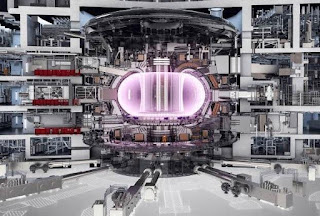NASA’s Parker Solar Probe…aiming to Advance Nuclear Fusion Technology Part 3 of 3
NASA’s Parker
Solar Probe…aiming to Advance Nuclear Fusion Technology
Part Three
By E. Stanley Ukeni
In the first part of this three
part article on the significance of NASA’s Parker Solar Probe expedition to the
sun’s corona, I alluded to the possibility of the discovery of an exotic
wave-particle that that I dubbed ‘Spectrion’, and of which I professed would
revolutionize the field of fusion science—and lead to a major breakthrough in
the construction of functional fusion reactors. I think it’s only natural that
I expound on fusion technology and its immense potential to transform our world
for the better.
Imagine the possibility of a
commercially viable nuclear fusion power plant that would provide clean,
efficient, safe and sustained energy source that powers our entire world—with
its source of fuel abundantly available, and easily accessible. This promise of fusion technology offers a
tantalizing solution to powering our world while helping militate against
climate change.
Nuclear fusion is a
self-sustaining process of generating near inexhaustible energy—the same way
the sun and all the stars in the universe produce energy. The process sort of
involves fusing lightweight atomic nuclei by subjecting it to high pressures
and temperatures of approximately 150 million degrees Celsius (270 million
degrees Fahrenheit) hotter than the center of the sun.
In essence, a practical and
viable fusion process is achieved when more energy is derived than is used to
initiate and sustain it. Although physicists have long known that this process
of achieving cascade involves the combination of applying pressure, enhancing
the degree of temperature and allowing the time for reaction to reach a
critical value, at which point the reaction becomes self-sustaining, the
ability to manage the turbulence that occurs inside the plasma reactor has
remained largely elusive.
Principally, fusion reaction is
created using hydrogen isotopes, such as deuterium, which can be readily
extracted from seawater—ensuring an abundant supply of the requisite fuel
needed to power the fusion process. To put this in prospective, one out of
every 6,500 atoms of hydrogen in seawater is deuterium—this means that,
proportionally, a gallon of water contains the same amount of energy as 300
gallons of gasoline.
In a nutshell, a
self-sustaining fusion cascade occurs when hydrogen atoms, having been
subjected to intense heat and pressure, overcomes their natural repulsion of
one another, collide at incredibly high speeds—fusing into helium. The process
of this collusion releases massive amounts of energy.
It is believed that a similar
process is what fuels our sun’s sustained energy generation process, but I’m of
the sense that there is a more complex reaction occurring in our sun’s core,
which allows it to sustain its fusion process.
The possibility of fusion
energy—an inexhaustible and clean source of electrical power, has long been an
elusive ‘holy grail’ of nuclear science. For over six decades, scientists have
been working toward the development of a functional nuclear fusion reactor,
with limited success. The problem that has long hampered the development of a
functional fusion reactor, I believe, lies in the detection of the Spectrion
wave-particle. The NASA’s Parker Solar Probe offers astrophysicists the best
chance of discovering the elusive Spectrion.
Indeed, fusion technology has
come a long way since the 1930s, when the first fusion experiment was
conducted. Since that initial prove-of-concept experiment, fusion physics
laboratories were established around the world. As of the 1950s, prototype
rudimentary fusion machines reactors were being operated in the then Soviet
Union, the United States, the United Kingdom, France, Germany and Japan.
However, it was not until 1968
when a major breakthrough in fusion technology occurred. In a stroke of genius,
Soviet scientists developed a revolutionary type of fusion reactor that
employed a unique approach to plasma containment, in the form of a
doughnut-shaped magnetic confinement device, called a Tokamak.
Although there have been marked
breakthroughs in the theoretical science involved in creating fusion energy
here on earth, there still remains a number of fundamental problems with the
physics of engineering reactors that generate cheap and abundant power for all,
on self-sustained bases.
I believe that the lack of
progress building a fully functional fusion reactor the yet to be reconciled
gap in the knowledge of the nature of all of the particles that sustain fusion
reaction in the sun. Once astrophysicists can fully understand the process at
work within the sun’s core, they can readily replicate this process, with
predictable outcome—success.
I am confident that the Parker
Solar Probe will provide greater insight, which will fundamentally influence
human understanding of how the sun works, and of the discovery of the Spectrion
wave-particle. I am certain that the knowledge they would gain advance fusion
science by leaps and bounds.
I particularly like fusion
technology because it complements our current push towards weather-dependent
energy sources like solar and wind. Equally, fusion reactors generally occupy
limited physical space, as such would not displace natural habitats and useable
farmlands. This is quite desirable considering the growing human population.
Once scientists successfully
solves the fundamental problems associated with building viable fusion
reactors, the prospects of establishing sustainable human colonies in other
habitable planets, such as Mars, would become highly feasible. This is because;
fusion technology could conceivable power future space craft on deep space
explorations. It would provide near inexhaustible electrical energy to power
life-sustaining biospheres for human colonists who would settle yet to be
discovered alien planets.
Equally, a viable fusion
technology will be used to process waste and recycle its elements. It would be
used to produce fuel for fission reactors, and process radioactive fuel wastes.
I am sure that there are those
who are wondering about the downside and dangers of fusion reactors. Of course,
every nuclear power technology carries some inherent risks. However, fusion
technology offers limited, and I dare say negligible, risks to humans.
Now, for those of you who are
still not convinced that fusion technology is worth all the trouble of
venturing into the outer edging of the sun to harness the last secret of
unlimited energy source, here are a few reasons to persuade you of the
necessity of accelerate the mastery and
development this vital energy source;
·
Nuclear fusion reactors do not emit CO2—one of
the primary contributors to greenhouse gases.
·
Fusion technology produces minimal amount of
radioactive waste—the byproduct of its reaction are non-radioactive helium and neutron.
·
Fusion reactors produce thrice the power of
conventional fission reactor.
·
It does not carry the risk of a nuclear meltdown
and environmental contamination as fission technology.
Authored by E. Stanley Ukeni, ©
2017. All Rights Reserved. This material and other articles or stories posted
on this blog site may not be reproduced, published, broadcast, rewritten or
redistributed, in whole or in part, without prior expressed written permission
from the author, E. Stanley Ukeni.
You are invited to follow E.
Stanley Ukeni on twitter at; @EzStan . You’re equally invited to follow him on
google+. Oh yeah, don’t forget to subscribe to this blog Site. Thanks.






Comments
Post a Comment